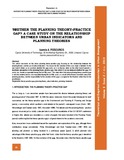Whither the planning theory-practice gap? A case study on the relationship between urban indicators and planning theories
| dc.contributor.author | Pissourios, Ioannis | |
| dc.date.accessioned | 2015-12-07T11:03:52Z | |
| dc.date.available | 2015-12-07T11:03:52Z | |
| dc.date.issued | 2013-05 | |
| dc.identifier.uri | http://hdl.handle.net/11728/6318 | |
| dc.description.abstract | This article comments on the urban planning theory-practice gap, focusing on the relationship between the planning theory and the use of urban indicators. The reason for the selection of this case study is twofold. On the one hand it allows us to ascertain whether the gap exists, or is an illusion, while on the other hand it permits a diachronic perspective in the planning theory–practice gap, from which it can be deduced whether the gap, if i exists, has shrunk or expanded during the last fifty years. The study infers that urban planning theory–practice gap is not only evident, but has also expanded during the last fifty years as a result of the theory’s transition away from planning practice, and the responsibility for the creation of this gap is assigned to the theorists rather than to the practitioners. | en_UK |
| dc.language.iso | en | en_UK |
| dc.relation.ispartofseries | Theoretical and Empirical Researches in Urban Management;Volume 8 | |
| dc.rights.uri | http://creativecommons.org/licenses/by-nc-nd/4.0/ | en_UK |
| dc.subject | Theory-practice gap | en_UK |
| dc.subject | Planning theory | en_UK |
| dc.subject | Urban indicators | en_UK |
| dc.subject | Planning standards | en_UK |
| dc.title | Whither the planning theory-practice gap? A case study on the relationship between urban indicators and planning theories | en_UK |
| dc.type | Article | en_UK |
Files in this item
This item appears in the following Collection(s)
-
Articles73
Άρθρα


